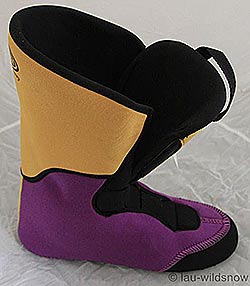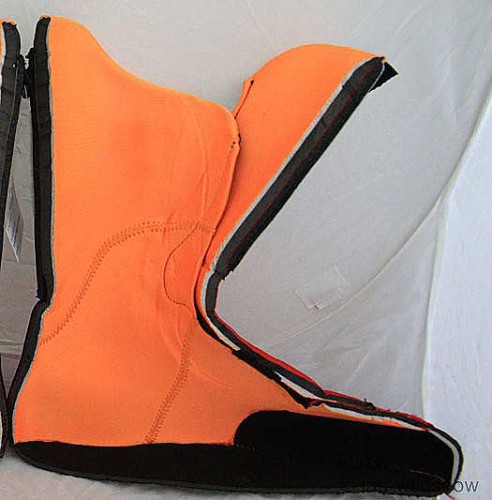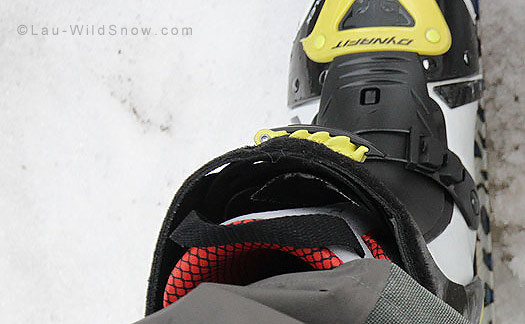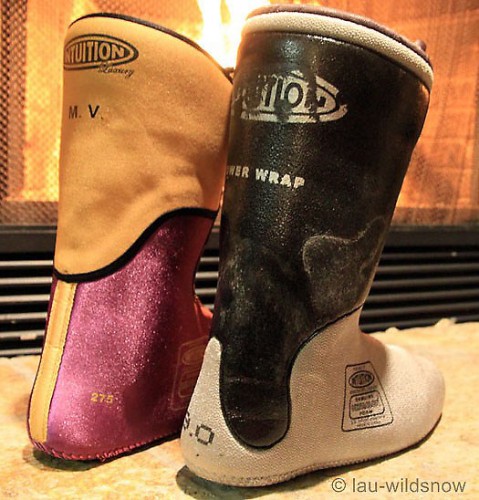
Intuition liner 2.0 is based on the Luxury Liner, but uses even more advanced materials.
It is not surprising that the Intuition 2.0 liner looks like Intuition’s other tongue liners (Luxury and Freeride liners) as they are based on the same panel construction design. I’ve already written quite a bit about Intuition’s other liners in a previous Wildsnow article so please reference that for more gushing praise.
The key difference in the Intuition 2.0 liner is the use in strategic locations a 4mm layer of a new Intuition foam. Intuition is calling this new foam “Enact PE.” Enact PE can be distinguished from the very soft “Flexalon” foam used only in the Intuition Pro-tour liner, which was used in strategic spots in the Pro Tour liner to encourage tourability and walking/striding comfort for backcountry skiing. Enact PE is also differentiated from the standard Ultralon Intuition foam used in its other liners (including the wrap and tongue liners) by a change in thermoforming characteristics.
While all Intuition foam thermomolds somewhat as the liners are used (think sweaty feet and the heat they generate), the new 2.0 Enact PE foam accelerates in-use molding. Intuition anticipates that people who don’t have access to a shop who they can trust to thermomold a liner or who do not trust themselves to undertake a home-based liner bake (move that pie mate, I need the kitchen oven) will be drawn to the 2.0 liner and it’s off-the-shelf fit.
Having said that, the 2.0 liner can be cooked to expedite the breaking-in process. The downside to the accelerated thermomoldable characteristics of the Enact PE foam is that it may not be able to be cooked as frequently as the standard Intuition foam. Where Intuition suggests that its standard liners can be cooked 4 to 5 times, they anticipate that a user who oven or hot-air-blower molds a 2.0 liner might only get 3 or so molding heat/cool cycles out of their liner.
The logical target for the Intuition 2.0 liner is the OE market but this is of puerile interest to Wildsnow readers. In the backcountry skiing aftermarket, I would imagine that people with generic feet (those that fit the Intuition “phantom last”) who do not necessarily need their liners to be cooked might consider the 2.0 liner. Those who have unusual feet or who typically need a lot of boot/liner work would probably be best advised to get standard Intuition liners and liaise with a trusted bootfitter.

Cutout of the 2.0 Luxury liner showing a thicker (9mm) overlay of black standard Ultralon foam mixed in with the white thin (4mm) strip of Enact PE foam which is covered with an abrasion resistant fetching orange cover.
Fit & Performance
I used a size 9.0 and size 10 Intuition 2.0 liner in a Scarpa Mobe and in a soft Atomic alpine boot. I did not mold the liner. My boots are size 27.0 Mondo. I caveat my conclusions with the fact that I am a very generic foot. I find it easy to fit a lot of boots and liners.
I found both sizes of liners to have a comfortable out-of-the-box fit. Both liners had a very roomy toe-box which I appreciate for touring. I am actually testing the Scarpa Mobes and tried to use the stock Scarpa liner (basically OE Intuition luxury liners with custom foam thicknesses for Scarpa) but found the Intuition 2.0 liners to be more comfortable for touring then the OE Mobe liners. I’ve had 9 days on the Intuition 2.0 liners on the Mobe.
Subsequently I have used these same liners for 40 more days of touring in Dynafit ZZeus and Scarpa Maestrale boots. I also have a thin version of the liners which just have 4mm of foam underfoot and are the lowest volume liner ever made by Intuition, I installed these in a Dynafit TLT5 Performance and used for 5 days. My personal Intuition 2.0 liners are still comfortable and do not show any signs of packing out (I compared them to another sample pair which I have in my alpine boots which have only been used 5 days).

Intuition 2.0 liner in Dynafit TLT5. Liner upgrades over OEM are not necessary for everyone, but always something to consider if you have even the slightest problem getting a stock liner and boot to fit and ski well.
Even more illuminating was that Intuition provided my very-fussy-about-her feet-wife some Intuition 2.0 liners. She has used them without complaint regarding fit and has more than 40 days on them. This is in contrast with her standard Intuition liners which required fitting by Intuition. My conclusions from this very isolated single datapoint is that the off-the-shelf fit of the Enact PE Intuition 2.0 liner is indeed remarkable.
There isn’t much to say about the performance that has not already been said. The Intuition 2.0 liner skied like any other Intuition tongued liner; which is to say very well. It’s not as tall or stiff as the wrap liners but is still a best-in-class upgrade over many OE liners.
Of note, Intuition has listened to customer feedback regarding footbeds in liners and has resiled from their earlier recommendation/position that their liners do not need footbeds. While some people don’t need footbeds (I’m one of those), everyone’s feet are different and the Intuition 2.0 liner will be produced with different thicknesses of foam in forefoot and in the foot sections all with the goal of achieving off-the-shelf comfort but room for footbed if desired.
One downside of the 2.0 foam thicknesses is that my feet got cold in the Intuition 2.0 liner during an especially chilly spell this past season. I attribute this to the thinner foam used in the foot section of the liner (4mm and 6mm of foam compared to 12mm in my older Luxury liners). Solution is of course to either use an insulating footbed (most are), or in my case (since I don’t use arched footbeds), just a layer of insulating material under the foot or inside the boot shell under the liner.

Intuition 2.0 liner (left), taller Intuition Alpine Powerwrap liner (right)
Cost and how to buy
Cost of the Intuition 2.0 liner is the same as the standard Intuition Luxury liner – around $180.00. Liners are available either direct through Intuition or at Intuition retailers.
(Guest blogger Lee Lau is an avid skier and outdoorsman embarking on many adventures with his loving, and sometimes concerned wife, Sharon. He has over fifteen years of experience backcountry skiing and dabbles in mountaineering. In the “off-season” he is occasionally found working in his day job as an intellectual property lawyer when he is not mountain biking. As a resident of Vancouver and Whistler, British Columbia, Lee’s playground extends mainly to Western Canada, including South West B.C. and the Selkirks. Lee writes here.)
Guest blogger Lee Lau is an avid skier and outdoorsman embarking on many adventures with his loving, and sometimes concerned wife, Sharon. He has over 15 years of experience skiing, ski-touring and dabbles in mountaineering. In the “off-season” he is occasionally found working in his day job as an intellectual property lawyer when he is not mountain biking. As a resident of Vancouver, British Columbia, Lee’s playground extends mainly to Western Canada, including South West B.C. and the Selkirks.
